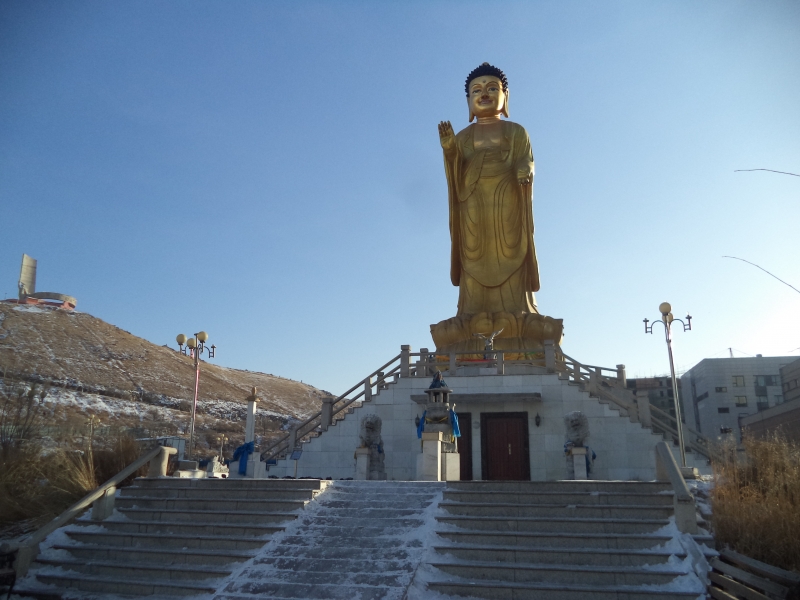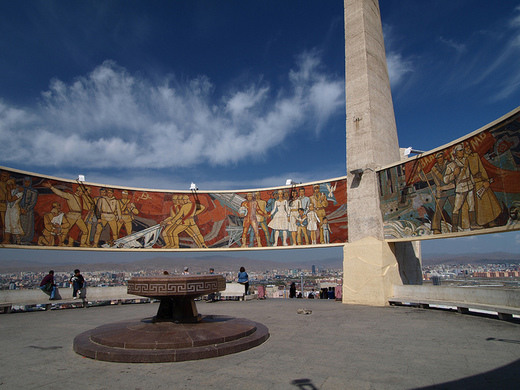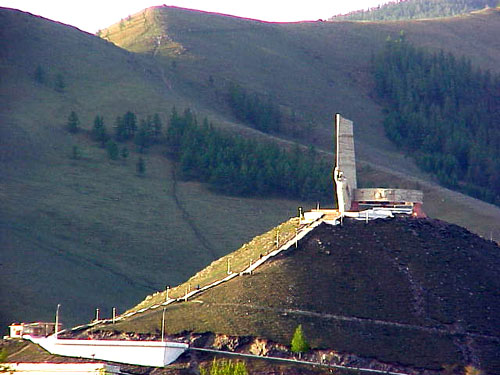zaisan hill
Zaisan Hill
The Zaisan memorial lies in the foothills to the south of Ulan Bator (i.e. Ulaanbaatar). It was built by the Russians as a monument to Soviet soldiers fallen in World War Two. A tiled mural lies within a huge concrete ring, which is raised about 5 metres above the ground. Zaisan is a popular tourist attraction and one of the highlights of Ulan Bator due to the fantastic views it offers over the city.
The Zaisan memorial lies about 20 minute's walk up a steep hill of a few hundred steps. It makes a pleasant day trip out from the city, and is a popular Ulan Bator tourist attraction for both foreigners and Mongolians alike. The excellent views over Ulaanbaatar give one an appreciation of the size of the ever-sprawling city, and a good view of the Tuul River as it winds its way from the heights of Terelj national park down between the factories and power stations of Ulan Bator. You can also get an aerial view over the yurt districts, and see how many cranes there are rapidly altering the city skyline with brand new, soviet-style apartment buildings.
Older guide books might mention Zaisan memorial as a good place to start a trek through Bogd Khan Uul Strictly Protected Area but unfortunately the urban sprawl has now encroached upon the formerly-pristine area behind the monument (a cynic might wonder at what arrangements the developers of the luxury apartment complex have made with the government to build on protected national parkland), so you're probably better off starting your hike further south. You can just stay on the bus (read below) as it heads up about 800m further before stopping and turning around at the big walls of what looks to be a prison. You could get off the bus there to start your walk into Bogd Khan Uul area.
The mosaic mural depicts, in 'Socialist realism' style, Soviet soldiers accepting the surrender of Nazi and Japanese forces during World War II. It is more a celebration of Russian achievement and humility in victory.
The Japanese surrender relates to the battle of Khalkin River (or 'Khalkin Gol', in Mongolian), which took place near the eastern Mongolian city of Choibalsan at the outset of the war in 1939. The Japanese, who had brutally occupied most of China at this time, were continually probing the Soviet-protected Mongolian border over a period of 8 years. [Being a 'Japanese spy' was a common confession sought from victims of the Communist purges during the early 1930s]. This eventually escalated into the battle of Khalkin Gol, one of the first major battles of WWII which is still of great significance to Russians and Mongolians.
Over 100,000 soldiers fought in the battle of Khalkin Gol. It is estimated that about 45,000 Japanese, and 17,000 Soviets, died in the battle over a few weeks. The Soviets eventually triumphed due to heavy tanks and artillery and a superior supply chain, and the Japanese surrendered. Some Japanese were later tried for illegal aggression, and shot or sent to prison camps (not depicted in the memorial!). The Mongolians (now Communists) also fought valiantly on the side of the Russians, and rode out bravely against the heavy guns of the Japanese with nothing but their horses and small arms. In the Zaisan memorial mural, the Mongolians on horseback are depicted next to the Russians, and Zaisan is often known to Mongolians as a tribute to Mongolian and Russian friendship. Leading the Mongolian side was Khorloogiin Choibalsan, who later became Field Marshall then President of Mongolia and presided over the brutal Stalinist purges throughout the country. It's likely that it is Choibalsan depicted holding his horse next to the Russians, while another Mongolian is being commended by a Soviet tank driver for his bravery.





